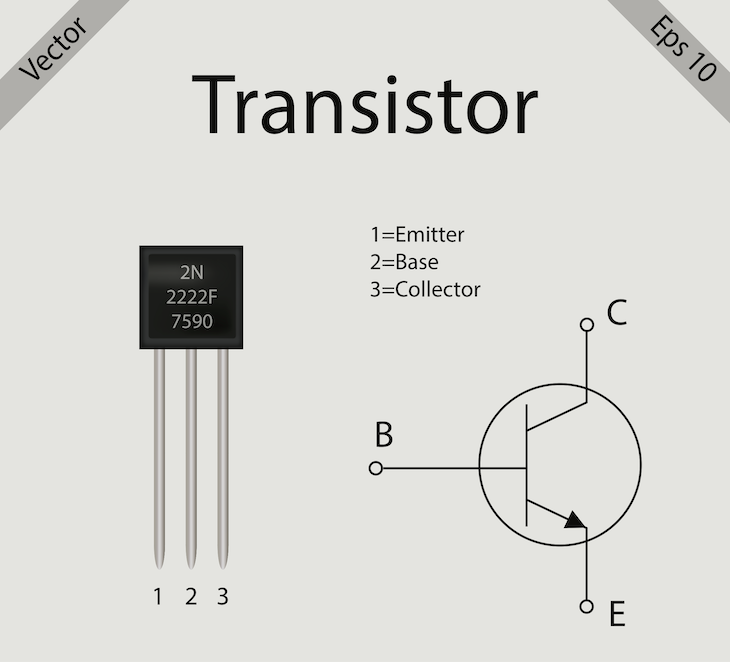Transistors are made of materials like silicon or germanium that are capable of allowing electrical current to flow through them in a controlled manner. The materials of transistors are doped, or “treated,” with impurities to create a structure called a p-n junction. In this case, “p” stands for positive and the “n” stands for negative. These notations refer to the type of dopant atoms (impurities) that have been added to the semiconductor material.
Transistor Definition
A transistor is a device that controls an electrical current by amplifying, facilitating or stopping it. Transistors can be found in computer memory chips, cell phones and car engines, among other applications.
The most common type of transistor is the metal-oxide-semiconductor field-effect transistor (MOSFET), which is widely used in electronic devices such as computers, smartphones and televisions.
What Is a Transistor?
A transistor is a device that controls an electrical current by acting as an amplifier or a switch. As an amplifier, a transistor can increase the electrical output, even if the input is small. As a switch, a transistor can alternate between ‘on’ and ‘off’ phases to manage the electrical current. These abilities have made transistors important for everyday applications, ranging from computers to space satellites.
Components of a Transistor
A transistor consists of three main parts: the emitter, base and collector.
Emitter
The emitter is the top layer of the transistor that serves as the source of electrons. It’s heavily doped and consists of a conductive material like copper or aluminum.
Base
The base is the middle layer of the transistor that acts as the control terminal. It’s lightly doped and regulates the flow of electrons from the emitter to the collector.
Collector
The collector is the bottom layer of the transistor and serves as the drain, collecting electrons sent from the emitter. It’s larger than the emitter and base but moderately doped. The collector is made of less conductive materials like silicon or aluminum.
How Do Transistors Work?
When a small current flows through the base, it controls the flow of a much larger current between the emitter and the collector. This is due to the fact that the base-emitter junction is forward-biased, allowing electrons to flow from the emitter to the base. The base-collector junction is reverse-biased, which means that electrons are prevented from flowing from the base to the collector. However, when a current flows through the base it opens up the base-collector junction and allows electrons to flow from the emitter to the collector.
This process allows the base to control the flow of current between the emitter and collector so we may use the transistor in a variety of ways.

Why Do We Use Transistors?
A transistor can act as a switch or gate for electronic signals. In practice, this means we use transistors as electronic switches that turn electronic circuits on or off. This is a basic function that we use in digital logic circuits, such as those found in computers, where we use transistors to represent the ones and zeros of binary code.
We can also use transistors to control the power supply to different electronic components. The transistor acts as a switch to turn on and off the current flow. In addition, we can use transistors to adjust the voltage level, which allows for the efficient use of power in electronic devices.
One of the most important uses of transistors is as an amplifier. We can use transistors to amplify weak signals, such as the output from a microphone, to levels that can drive a loudspeaker.
What Are the 2 Main Types of Transistors?
BJT
In a BJT, the base-emitter junction is forward-biased by a small current. This configuration allows electrons to flow from the emitter to the base. The base-collector junction is reverse-biased, thereby acting as a barrier to the flow of electrons. However, the forward-biased base-emitter junction allows a small number of electrons to flow across the base-collector junction. This process creates a small current flow between the collector and emitter terminals that’s controlled by the base current.
FET
In an FET, the gate terminal is separated from the channel by an insulating material. Applying a voltage to the gate terminal creates an electric field that can attract or repel the free electrons in the channel. This process changes the conductivity of the channel and thus controls the flow of current between the source and drain terminals. FETs have high input impedance, which means they draw very little current from the input signal.
In this way, transistors act like a switch, or an amplifier, depending on how they’re connected and how much current flows through them. The input current controls the output current, which we can use to amplify or switch signals.
Why Are Transistors Important?
Transistors are versatile devices that can act as switches, amplifiers and signal regulators, enabling the processing and storage of digital information. The widespread use of transistors in electronic devices has greatly impacted our daily lives by enabling modern communication, entertainment, transportation and healthcare technologies. For example, transistors have made it possible to miniaturize electronic circuits, leading to the creation of portable devices such as smartphones, laptops and wearable technology.
It’s likely that the computer revolution and the rapid advancements in electronics wouldn’t have happened, as transistors are a key component in digital circuits and modern computing. This would have slowed down technological advancements in fields such as communications, entertainment, transportation and healthcare. Electronic devices would have been much larger, slower and less efficient. Meanwhile, portable devices such as smartphones, laptops and wearable technology wouldn’t exist.
Examples of Transistors
Transistors are used in a variety of electronic devices and equipment:
- Computers: Transistors are a fundamental building block of modern computers. We use them in digital logic circuits, memory chips and microprocessors.
- Cell Phones: In cell phones, transistors amplify signals and control the power supply to different components.
- Automotive: Modern cars and trucks use transistors for engine control, power inverters for electric drives, power windows and other electronic systems. In electric vehicles, transistors control the flow of electricity in the power electronic systems, allowing for efficient conversion and distribution of power.
- Space and Military: Transistors’ small size, low power consumption and high-performance characteristics make them ideal for use in satellites, missiles and other electronic systems used for defense and exploration.
- Robotics: Synthetic transistors are capable of simultaneously processing multiple inputs, allowing them to excel at memory-related tasks. The goal is to support advanced robotic systems that demonstrate more human-like learning.
- Healthcare: Transistors are used in wearable health devices to power real-time monitoring of health data.
- Energy: Transistors play a key role in solar charge controllers, which regulate the electrical current between the components of a solar panel system.
- Manufacturing: In factories, transistors can act as switches to power machinery at the appropriate times. They can also regulate LED lighting systems, contributing to workplace safety in manufacturing facilities.
Frequently Asked Questions
What are the two main functions of a transistor?
A transistor serves as an amplifier, increasing an input to produce a larger output. Transistors also act as switches, alternating between ‘on’ and ‘off’ phases to allow electrical currents to pass through only at certain times.
How is a transistor used in computers?
Transistors can be found in the circuits, chips and microprocessors of computers. By acting as a switch, a transistor can regulate electrical currents to produce the binary data computers rely on to process information.
What is an example of a transistor?
An everyday example of transistors occurs in cell phones. Transistors regulate electrical currents in different parts of a mobile phone, strengthen signals when needed and contribute to processing and memory tasks.





